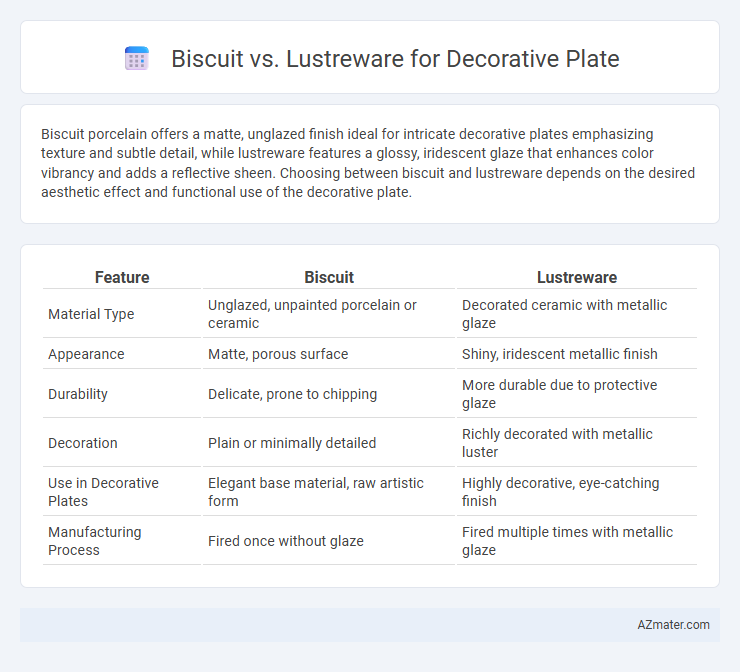Biscuit porcelain offers a matte, unglazed finish ideal for intricate decorative plates emphasizing texture and subtle detail, while lustreware features a glossy, iridescent glaze that enhances color vibrancy and adds a reflective sheen. Choosing between biscuit and lustreware depends on the desired aesthetic effect and functional use of the decorative plate.
Table of Comparison
| Feature | Biscuit | Lustreware |
|---|---|---|
| Material Type | Unglazed, unpainted porcelain or ceramic | Decorated ceramic with metallic glaze |
| Appearance | Matte, porous surface | Shiny, iridescent metallic finish |
| Durability | Delicate, prone to chipping | More durable due to protective glaze |
| Decoration | Plain or minimally detailed | Richly decorated with metallic luster |
| Use in Decorative Plates | Elegant base material, raw artistic form | Highly decorative, eye-catching finish |
| Manufacturing Process | Fired once without glaze | Fired multiple times with metallic glaze |
Introduction to Decorative Plate Materials
Decorative plates crafted from biscuit porcelain exhibit a matte, unglazed finish that highlights fine details and soft textures, making them ideal for intricate designs. Lustreware plates, distinguished by their iridescent glaze, offer a reflective, shimmering surface that enhances visual appeal with vibrant colors and metallic tones. Choosing between biscuit and lustreware depends on the desired aesthetic effect and the specific decorative style sought for collectible or display purposes.
Overview of Biscuit Porcelain
Biscuit porcelain, also known as bisque, is unglazed, matte-finished porcelain renowned for its delicate, chalky texture that highlights intricate detailing on decorative plates. This type of porcelain is valued for its natural ivory or white coloration, offering a soft, elegant appearance that distinguishes it from the glossy, reflective surface of lustreware. Biscuit porcelain plates are favored in fine art and antique collections for their subtlety and the way they emphasize sculptural features without the distraction of glaze or metallic sheen.
Understanding Lustreware Techniques
Lustreware decorative plates feature a unique metallic glaze achieved through a complex firing process that deposits thin layers of metal oxides, creating an iridescent sheen distinct from the matte, unglazed surface of biscuit porcelain. The lustre effect is obtained by applying a metallic pigment, often containing silver, copper, or gold, to the plate's surface, then firing it at a lower temperature in a reduction kiln to produce the signature shimmering finish. Understanding these techniques highlights lustreware's intricate craftsmanship and visual appeal, differentiating it from the simpler, more subdued aesthetic of biscuit plates.
Visual Aesthetics: Matte vs Glossy Finish
Biscuit decorative plates feature a distinctive matte finish, offering a soft, muted appearance that highlights intricate details with subtle elegance. Lustreware decorative plates exhibit a glossy finish characterized by a reflective, iridescent sheen that enhances color vibrancy and creates a striking visual impact. The choice between biscuit's understated texture and lustreware's lustrous brilliance ultimately defines the aesthetic appeal and mood of the decorative display.
Durability and Maintenance Differences
Biscuit decorative plates, made from unglazed porcelain, offer a matte finish that is more prone to chipping and staining, requiring gentle cleaning with a soft cloth and avoiding water exposure to maintain their delicate surface. Lustreware plates feature a metallic glaze that enhances durability and provides resistance to scratches and fading, making them easier to clean with mild soap and water without risking damage. When choosing between the two, Lustreware generally offers superior durability and lower maintenance compared to the more fragile and high-maintenance Biscuit finish.
Artistic Expression and Design Potential
Biscuit porcelain offers a matte, unglazed finish that enhances fine details and delicate textures, providing artists with a subtle yet refined surface for intricate decorative plate designs. Lustreware features a metallic, iridescent glaze that creates vibrant, reflective effects, allowing for bold and dynamic artistic expressions on decorative plates. Both Biscuit and Lustreware present unique design potentials, with Biscuit excelling in understated elegance and realism, while Lustreware emphasizes vivid color play and glossy sophistication.
Historical Significance of Biscuit and Lustreware
Biscuit porcelain, originating in the 18th century, is valued for its unglazed, matte finish that highlights intricate sculptural details and was often used by European porcelain manufacturers such as Sevres and Meissen. Lustreware, with its iridescent metallic glaze developed in the Middle East and popularized in the 19th century, reflects advancements in ceramic glazing techniques and cultural exchanges between Europe and Asia. Both decorative plate styles hold distinct historical importance, showcasing evolving artistry and technological innovation in ceramic production.
Collector’s Value: Biscuit vs Lustreware
Biscuit porcelain, known for its unglazed, matte finish, often holds higher collector's value due to its delicate craftsmanship and rarity in antique decorative plates. Lustreware, featuring an iridescent glaze, attracts collectors for its vibrant colors and reflective qualities but can vary widely in price depending on condition and manufacturer. Collectors prioritize biscuit pieces when seeking subtle elegance and historical significance, while lustreware appeals to those valuing decorative flair and artistic glazing techniques.
Suitability for Display and Use
Biscuit porcelain offers a matte, unglazed finish ideal for elegant display due to its delicate texture and fine detail, but it is more prone to chipping and less suited for regular use. Lustreware features a glossy, iridescent glaze that enhances visual appeal and durability, making it suitable for both decorative purposes and light functional use. Collectors often prefer biscuit for its refined artistry, while lustreware appeals to those seeking vibrant aesthetics combined with practical resilience.
Choosing the Right Decorative Plate Material
Choosing the right decorative plate material involves understanding the unique qualities of biscuit and lustreware. Biscuit porcelain features an unglazed, matte finish that highlights intricate sculptural details and offers a soft, elegant appearance ideal for classical decor. Lustreware, with its shimmering metallic glaze, provides a vibrant, reflective surface perfect for adding a luxurious, eye-catching accent to contemporary collections.

Infographic: Biscuit vs Lustreware for Decorative plate
 azmater.com
azmater.com